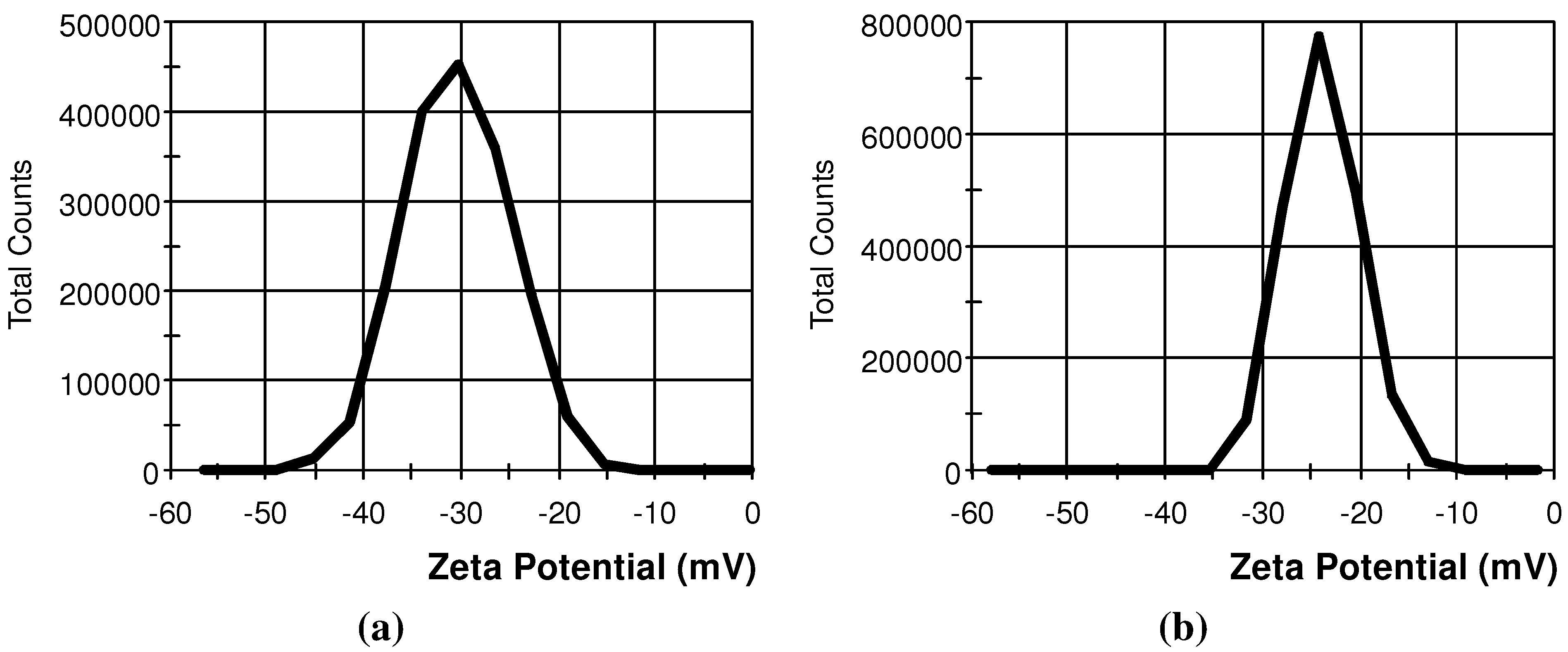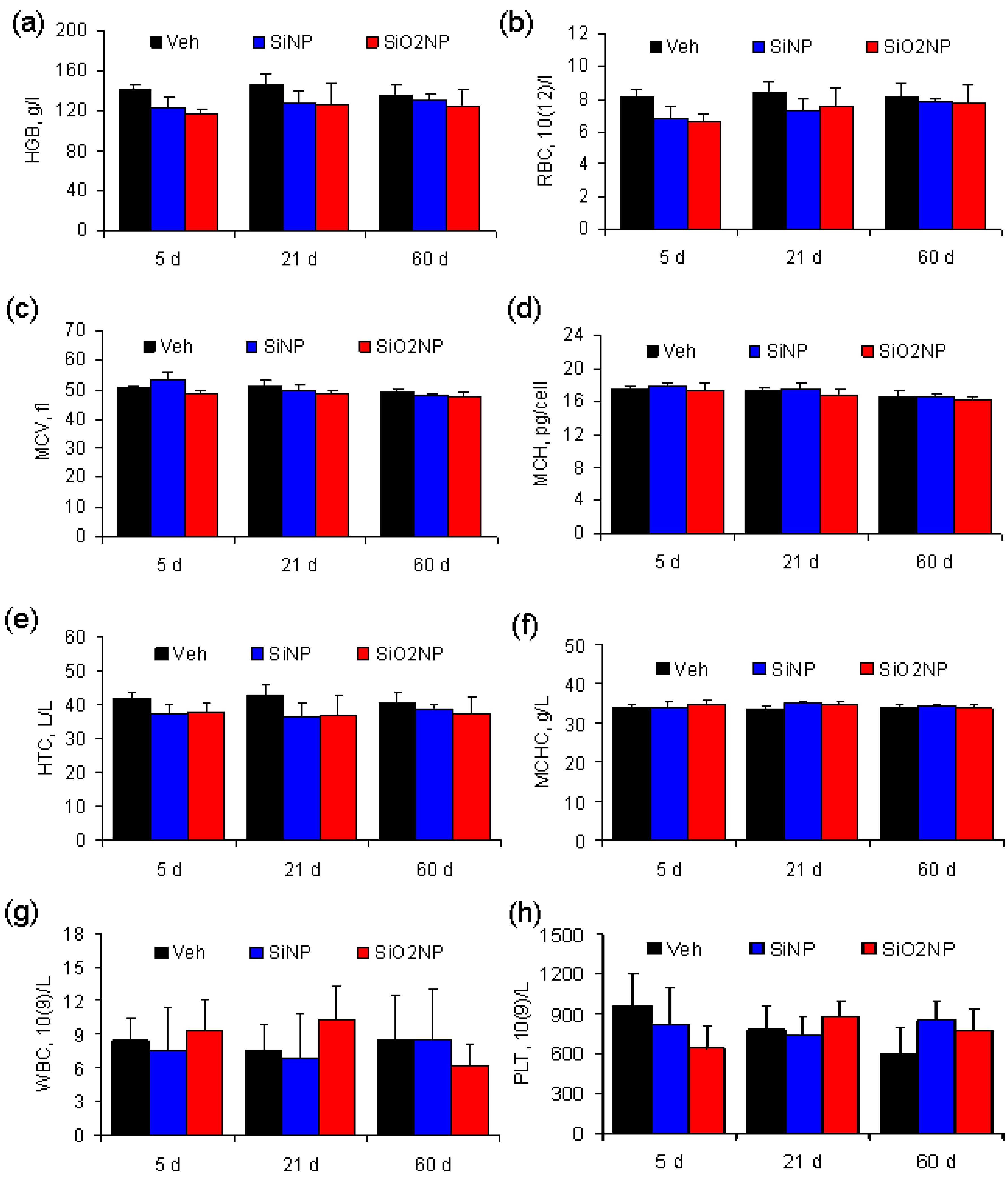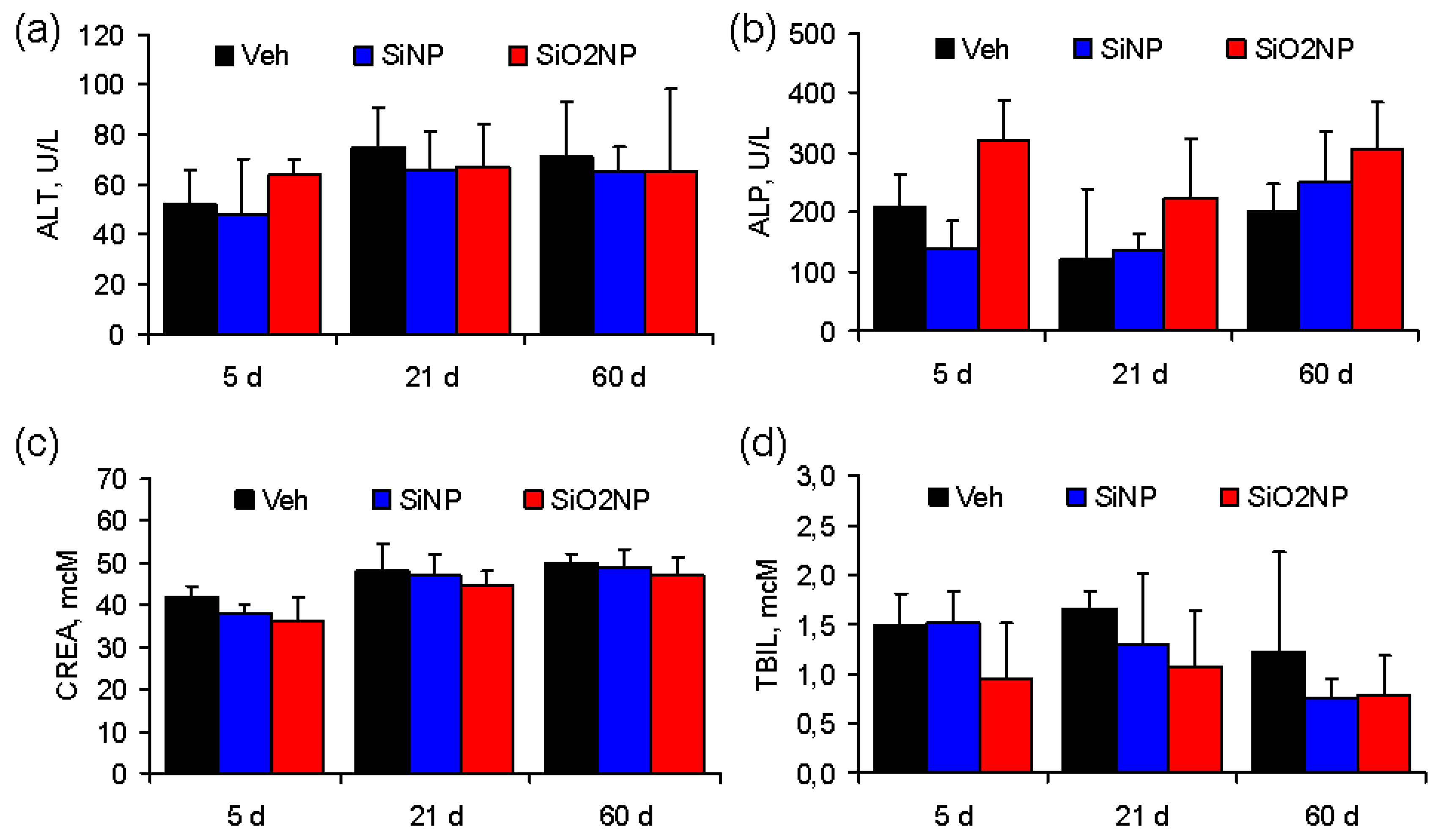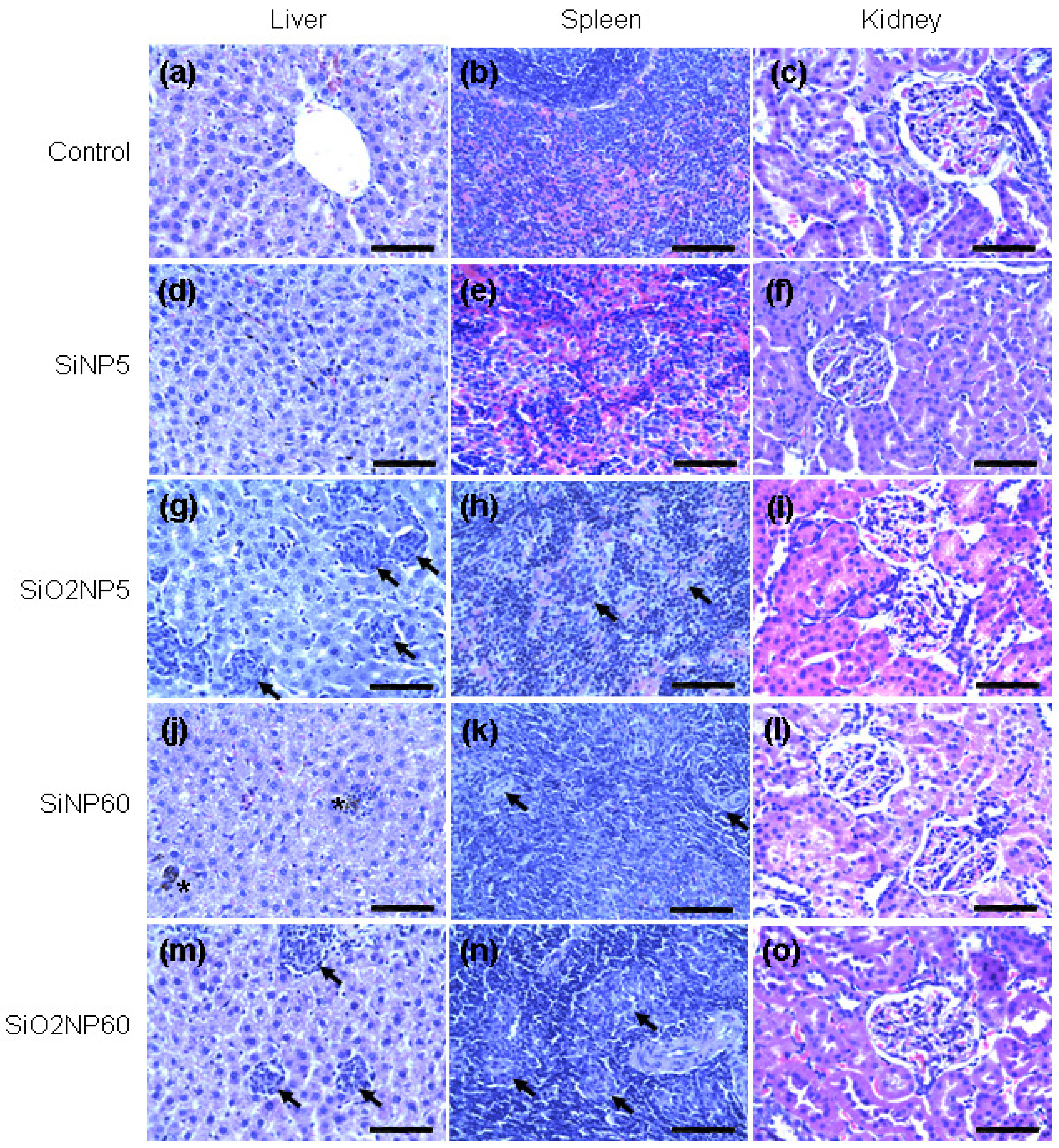In Vivo Toxicity of Intravenously Administered Silica and Silicon Nanoparticles
Abstract
:1. Introduction
2. Results and Discussion
2.1. Characterization of SiNPs and SiO2NPs


| Characteristics | SiNPs | SiO2NPs |
|---|---|---|
| Zeta potential, mV | 23.8 ± 3.74 | 30.4 ± 5.45 |
| Conductivity, mS/cm | 0.0155 ± 0.00082 | 0.00574 ± 0.00024 |
| Hydrodynamic diameter, nm | 150 ± 27 | 240 ± 114 |
| BET surface area, m2/g | 103 ± 12 | 175 ± 24 |
2.2. Hemodynamic Parameters
| Please add the title | Control (n = 6) | SiNPs (n = 7) | SiO2NPs (n = 6) | ||||
|---|---|---|---|---|---|---|---|
| HR (bpm) | MAP (mm Hg) | HR (bpm) | MAP (mm Hg) | HR (bpm) | MAP (mm Hg) | ||
| I | 2 min before infusion | 378 ± 36 | 106 ± 18 | 389 ± 37 | 115 ± 24 | 368 ± 33 | 110 ± 13 |
| End of infusion | 375 ± 32 | 108 ± 12 | 382 ± 28 | 111 ± 20 | 371 ± 34 | 109 ± 17 | |
| 10 min after infusion | 389 ± 42 | 112 ± 15 | 379 ± 38 | 114 ± 18 | 364 ± 39 | 114 ± 21 | |
| II | 2 min before infusion | 368 ± 37 | 111 ± 16 | 374 ± 36 | 108 ± 21 | 382 ± 31 | 118 ± 23 |
| End of infusion | 354 ± 38 | 109 ± 22 | 365 ± 34 | 112 ± 25 | 375 ± 30 | 119 ± 17 | |
| 10 min after infusion | 343 ± 33 | 105 ± 14 | 376 ± 32 | 117 ± 28 | 360 ± 27 | 115 ± 12 | |
| III | 2 min before infusion | 346 ± 39 | 118 ± 16 | 374 ± 36 | 115 ± 23 | 361 ± 37 | 117 ± 10 |
| End of infusion | 351 ± 36 | 116 ± 19 | 378 ± 25 | 109 ± 17 | 365 ± 32 | 112 ± 18 | |
| 10 min after infusion | 342 ± 35 | 114 ± 17 | 380 ± 48 | 113 ± 15 | 357 ± 27 | 108 ± 24 | |
2.3. Animal Body Weight

2.4. Inner Ear Function
2.5. Hematological Parameters

2.6. Biochemical Serum Markers

2.7. Histopathological Examination

2.8. Morphometric Analysis of Granulomas

3. Experimental Section
3.1. SiNPs and SiO2NPs
3.2. Transmission Electron Microscopy
3.3. Preparation of Aqueous Suspensions of NPs
3.4. Determination of Hydrodynamic Diameter, Zeta Potential, and Surface Area of NPs
3.5. Hemodynamic Measurements
3.6. Experimental Protocol
3.7. Evaluation of Inner Ear Function
3.8. Assessment of Hematological Parameters and Biochemical Serum Markers
3.9. Histopathological Examination
3.10. Morphometric Analysis of Liver and Spleen Sections
3.11. Statistical Analysis
4. Conclusions
Acknowledgments
References and Notes
- Ye, X.; Yang, D. Recent advances in biological strategies for targeted drug delivery. Cardiovasc. Hematol. Disord. Drug Targets 2009, 9, 206–221. [Google Scholar] [CrossRef] [PubMed]
- Lammers, T.; Hennink, W.E.; Storm, G. Tumour-targeted nanomedicines: Principles and practice. Br. J. Cancer 2008, 99, 392–397. [Google Scholar] [CrossRef] [PubMed]
- Galagudza, M.; Korolev, D.; Postnov, V.; Naumisheva, E.; Grigorova, Yu.; Uskov, I.; Shlyakhto, E. Passive targeting of ischemic-reperfused myocardium with adenosine-loaded silica nanoparticles. Int. J. Nanomedicine 2012, 7, 1–8. [Google Scholar] [CrossRef] [PubMed]
- Ulbrich, W.; Lamprecht, A. Targeted drug-delivery approaches by nanoparticulate carriers in the therapy of inflammatory diseases. J. R. Soc. Interface 2010, 7, S55–S66. [Google Scholar] [CrossRef] [PubMed]
- Van den Hoven, J.M; van Tomme, S.R.; Metselaar, J.M.; Nuijen, B.; Beijnen, J.H.; Storm, G. Liposomal drug formulations in the treatment of rheumatoid arthritis. Mol. Pharm. 2011, 8, 1002–1015. [Google Scholar]
- Galagudza, M.; Korolev, D.; Sonin, D.; Postnov, V.; Papayan, G.; Uskov, I.; Belozertseva, A.; Shlyakhto, E. Targeted drug delivery to ischemic heart with use of nanoparticulate carriers: Concepts, pitfalls and perspectives. J. Manuf. Technol. Manage. 2010, 21, 930–949. [Google Scholar] [CrossRef]
- Parveen, S.; Misra, R.; Sahoo, S.K. Nanoparticles: A boon to drug delivery, therapeutics, diagnostics and imaging. Nanomedicine 2012, 8, 147–166. [Google Scholar] [CrossRef] [PubMed]
- Park, J.H.; Gu, L.; von Maltzahn, G.; Ruoslahti, E.; Bhatia, S.N.; Sailor, M.J. Biodegradable luminescent porous silicon nanoparticles for in vivo applications. Nat. Mater. 2009, 8, 331–336. [Google Scholar] [CrossRef] [PubMed]
- Tang, F.; Li, L.; Chen, D. Mesoporous silica nanoparticles: Synthesis, biocompatibility and drug delivery. Adv. Mater. 2012, 24, 1504–1534. [Google Scholar] [CrossRef] [PubMed]
- Napierska, D.; Thomassen, L.C.; Lison, D.; Martens, J.A.; Hoet, P.H. The nanosilica hazard: Another variable entity. Part. Fibre Toxicol. 2010, 7, 39. [Google Scholar] [CrossRef] [PubMed] [Green Version]
- Slowing, I.I.; Vivero-Escoto, J.L.; Wu, C.W.; Lin, V.S. Mesoporous silica nanoparticles as controlled release drug delivery and gene transfection carriers. Adv. Drug Deliv. Rev. 2008, 60, 1278–1288. [Google Scholar] [CrossRef] [PubMed]
- Malvindi, M.A.; Brunetti, V.; Vecchio, G.; Galeone, A.; Cingolani, R.; Pompa, P.P. SiO2 nanoparticles biocompatibility and their potential for gene delivery and silencing. Nanoscale 2012, 4, 486–495. [Google Scholar] [CrossRef] [PubMed]
- Ye, Y.Y.; Liu, J.W.; Chen, M.C.; Sun, L.J.; Lan, M.B. In vitro toxicity of silica nanoparticles in myocardial cells. Environ. Toxicol. Pharmacol. 2010, 29, 131–137. [Google Scholar] [CrossRef] [PubMed]
- Napierska, D.; Thomassen, L.C.; Rabolli, V.; Lison, D.; Gonzalez, L.; Kirsch-Volders, M.; Martens, J.A.; Hoet, P.H. Size-dependent cytotoxicity of monodisperse silica nanoparticles in human endothelial cells. Small 2009, 5, 846–853. [Google Scholar] [CrossRef] [PubMed]
- Kumar, R.; Roy, I.; Ohulchanskky, T.Y.; Vathy, L.A.; Bergey, E.J.; Sajjad, M.; Prasad, P.N. In vivo biodistribution and clearance studies using multimodal organically modified silica nanoparticles. ACS Nano 2010, 4, 699–708. [Google Scholar] [CrossRef] [PubMed]
- Xie, G.; Sun, J.; Zhong, G.; Shi, L.; Zhang, D. Biodistribution and toxicity of intravenously administered silica nanoparticles in mice. Arch. Toxicol. 2010, 84, 183–190. [Google Scholar] [CrossRef] [PubMed]
- Nishimori, H.; Kondoh, M.; Isoda, K.; Tsunoda, S.; Tsutsumi, Y.; Yagi, K. Silica nanoparticles as hepatotoxicants. Eur. J. Pharm. Biopharm. 2009, 72, 496–501. [Google Scholar] [CrossRef] [PubMed]
- Nishimori, H.; Kondoh, M.; Isoda, K.; Tsunoda, S.; Tsutsumi, Y.; Yagi, K. Histological analysis of 70-nm silica particles-induced chronic toxicity in mice. Eur. J. Pharm. Biopharm. 2009, 72, 626–629. [Google Scholar] [CrossRef] [PubMed]
- Cho, M.; Cho, W.S.; Choi, M.; Kim, S.J.; Han, B.S.; Kim, S.H.; Kim, H.O.; Sheen, Y.Y.; Jeong, J. The impact of size on tissue distribution and elimination by single intravenous injection of silica nanoparticles. Toxicol. Lett. 2009, 189, 177–183. [Google Scholar] [CrossRef] [PubMed]
- Isoda, K.; Hasezaki, T.; Kondoh, M.; Tsutsumi, Y.; Yagi, K. Effect of surface charge on nano-sized silica particle-induced liver injury. Pharmazie 2011, 66, 278–281. [Google Scholar] [PubMed]
- Canham, L.T. Bioactive silicon structure fabrication through nanoetching techniques. Adv. Mater. 1995, 7, 1033–1037. [Google Scholar] [CrossRef]
- Aggarwal, P.; Hall, J.B.; McLeland, C.B.; Dobrovolskaia, M.A.; McNeil, S.E. Nanoparticle interaction with plasma proteins as it relates to particle biodistribution, biocompatibility and therapeutic efficacy. Adv. Drug Deliv. Rev. 2009, 61, 428–437. [Google Scholar] [CrossRef] [PubMed]
- Graf, C.; Gao, Q.; Schütz, I.; Noufele, C.N.; Ruan, W.; Posselt, U. Surface functionalization of silica nanoparticles supports colloidal stability in physiological media and facilitates internalization in cells. Langmuir 2012, 28, 7598–7613. [Google Scholar] [CrossRef] [PubMed]
- Abrashkin, K.A.; Izumikawa, M.; Miyazawa, T.; Wang, C.H.; Crumling, M.A.; Swiderski, D.L.; Beyer, L.A.; Gong, T.W.; Raphael, Y. The fate of outer hair cells after acoustic or ototoxic insults. Hear. Res. 2006, 218, 20–29. [Google Scholar] [CrossRef] [PubMed]
- Xie, G.; Sun, J.; Zhong, G. Tissular localization and excretion of intravenously administered silica nanoparticles of different sizes. J. Nanopart. Res. 2012, 14, 671. [Google Scholar] [CrossRef]
- Liu, T.; Li, L.; Teng, X.; Huang, X.; Liu, H.; Chen, D.; Ren, J.; He, J.; Tang, F. Single and repeated dose toxicity of mesoporous hollow silica nanoparticles in intravenously exposed mice. Biomaterials 2011, 32, 1657–1668. [Google Scholar] [CrossRef] [PubMed]
- Hao, Y.; Yang, X.; Song, S.; Huang, M.; He, C.; Cui, M.; Chen, J. Exploring the cell uptake mechanism of phospholipid and polyethylene glycol coated gold nanoparticles. Nanotechnology 2012, 23. [Google Scholar] [CrossRef]
- Gupta, A.; Wiggers, H. Surface chemistry and photoluminescence property of functionalized silicon nanoparticles. Phys. E 2009, 41, 1010–1014. [Google Scholar] [CrossRef]
- Goller, B.; Polisski, S.; Wiggers, H.; Kovalev, D. Silicon nanocrystals dispersed in water: photosensitizers for molecular oxygen. Appl. Phys. Lett. 2010, 96. [Google Scholar] [CrossRef]
- Institute of Laboratory Animal Research; Commission on Life Sciences; National Research Council. Guide for the Care and Use of Laboratory Animals; The National Academies Press: Washington, DC, USA, 2011. [Google Scholar]
- Tanaka, K.; Morimoto, J.; Kon, S.; Kimura, C.; Inobe, M.; Diao, H.; Hirschfeld, G.; Weiss, J.M.; Uede, T. Effect of osteopontin alleles on beta-glucan-induced granuloma formation in the mouse liver. Am. J. Pathol. 2004, 164, 567–575. [Google Scholar] [CrossRef] [PubMed]
© 2012 by the authors; licensee MDPI, Basel, Switzerland. This article is an open access article distributed under the terms and conditions of the Creative Commons Attribution license (http://creativecommons.org/licenses/by/3.0/).
Share and Cite
Ivanov, S.; Zhuravsky, S.; Yukina, G.; Tomson, V.; Korolev, D.; Galagudza, M. In Vivo Toxicity of Intravenously Administered Silica and Silicon Nanoparticles. Materials 2012, 5, 1873-1889. https://doi.org/10.3390/ma5101873
Ivanov S, Zhuravsky S, Yukina G, Tomson V, Korolev D, Galagudza M. In Vivo Toxicity of Intravenously Administered Silica and Silicon Nanoparticles. Materials. 2012; 5(10):1873-1889. https://doi.org/10.3390/ma5101873
Chicago/Turabian StyleIvanov, Sergey, Sergey Zhuravsky, Galina Yukina, Vladimir Tomson, Dmitry Korolev, and Michael Galagudza. 2012. "In Vivo Toxicity of Intravenously Administered Silica and Silicon Nanoparticles" Materials 5, no. 10: 1873-1889. https://doi.org/10.3390/ma5101873




